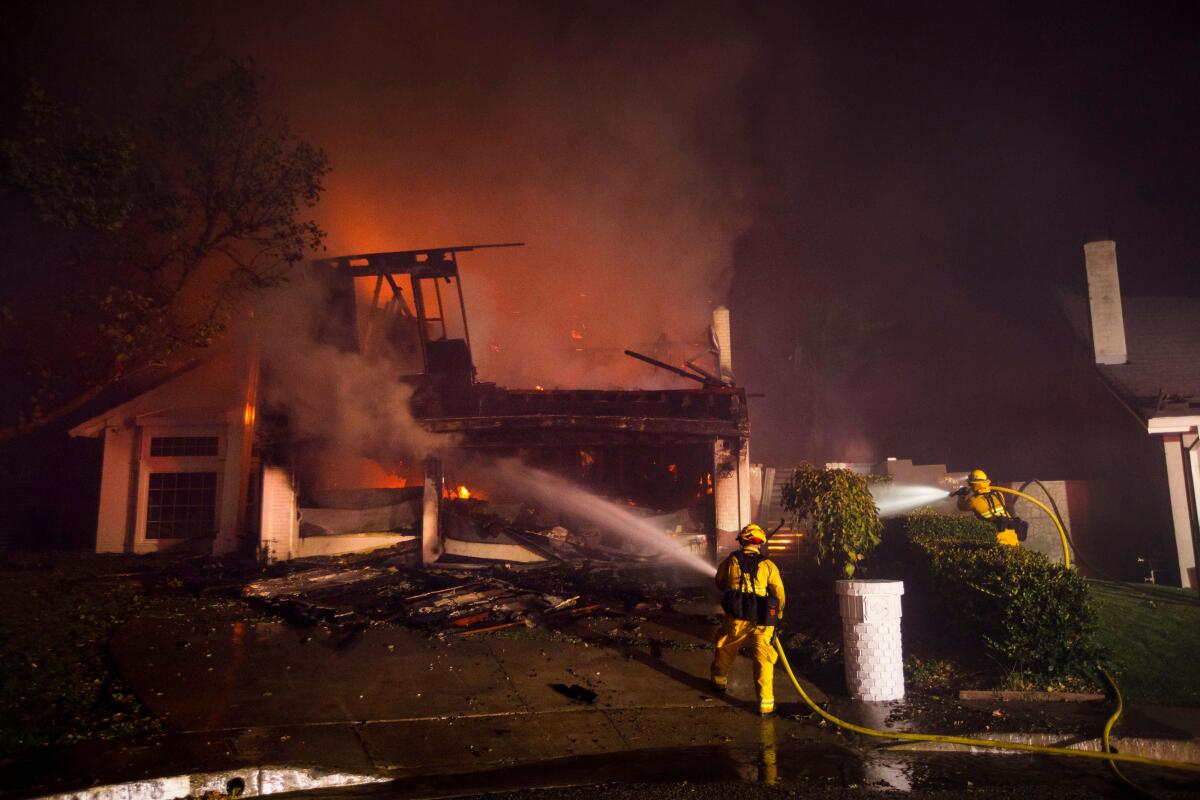Amid homeowner insurance crisis, consumer advocates and industry clash at hearing

- Share via
The fault lines running through California’s spiraling homeowners insurance crisis were on display Tuesday at a state hearing, where consumer advocates clashed with industry firms over a plan to allow insurers to use complex computer models to set premiums — a move state officials say will attract insurers to the market.
State Insurance Commissioner Ricardo Lara has proposed allowing insurers to employ so-called catastrophe modeling, which uses algorithms that predict the future risk properties face from wildfires, when setting the price of policies. Currently, rates are based on an insurance company’s past losses, which insurers increasingly dismiss as insufficient in light of the widespread acceptance that climate change has thrust California into a more dangerous future by causing more wildfires.
The models, which are in use in other states, are a key element of Lara’s strategy to moderate price increases by allowing more accurate calculation of risks while persuading insurers to do business in neighborhoods prone to wildfires. The move comes amid a recent stream of insurers exiting the California market with announcements they are not renewing policies or have stopped writing new ones.
Consumer groups worried at the hearing that the draft regulations would not allow enough scrutiny of the models, while several consulting firms that have developed them expressed concern about protecting their intellectual property.
“The algorithms and artificial intelligence that private ‘black box’ catastrophe models use will simply be tools for insurance company price gouging unless California mandates real transparency into how they impact prices and imposes real rules of the road regarding their design and use,” said Carmen Balber, executive director of Consumer Watchdog, an L.A. advocacy group that led the campaign for passage of Proposition 103, the 1988 measure that requires homeowners and auto insurers to get state approval for rate hikes.
The group, like other consumer advocates who spoke at the hearing, called on Lara to work with the state’s academic and insurance experts to develop a “public model,” in which all the factors that go into the computer simulations are available for everyone to review. Such a model could be used to set rates or benchmark privately developed models.
The draft regulations require those who want to review the models to sign nondisclosure agreements, which Consumer Watchdog has alleged will prevent its staff members from discussing the models among themselves.
Julia Borman, a director at Verisk, a company that builds computer models used by insurers, expressed concern that the draft proposal put forth by Lara would allow for a review by “countless participants and create the opportunity for an infinite timeline,” while not safeguarding companies from having their models ripped off by others
Michael Soller, the state Department of Insurance’s deputy commissioner for communications, said Lara has publicly stated that the draft rules will allow for the development of public catastrophe models, which the department might then use to evaluate the insurers’ proprietary models.
The proposal to allow catastrophe models is part of Lara’s larger Sustainable Insurance Strategy announced last fall. Other elements include righting the finances of the state’s Fair Access to Insurance Requirements plan, an insurer of last resort that has been deluged with new policyholders since insurers started pulling back from the market. He also wants to allow insurers to include in premiums the cost of reinsurance, which they purchase to protect themselves from disasters.
Catastrophe models are already allowed in California for pricing policies that cover earthquakes and fires caused by quakes. Along with wildfires, under the proposed regulations, the use of the models would also be permitted for insurance covering terrorism, floods and some other types of coverage.
Gerald Zimmerman, senior vice president of government and industry relations at Allstate, which stopped selling new homeowners insurance policies in the state in 2022, said that adopting Lara’s strategy would be a game changer. “Allstate will begin writing new homeowner insurance policies in nearly every corner of California,” he said.
Other speakers at the three-hour hearing included insurance agents and local officials, as well as homeowners groups, which want to ensure that catastrophe models take into account steps taken by homeowners and government agencies to reduce fire risks, such as by making homes more fire-resistant and reducing brush in a community. Although the draft regulations call for doing so, several speakers complained that such mitigation efforts had not been reflected in recent premium increases.
The Insurance Department plans to review Tuesday’s remarks in preparing for the release of a new set of proposed regulations. Lara has the support of Gov. Gavin Newsom, who issued a letter calling for the commissioner to move quickly to resolve the crisis. The regulations do not require legislative approval or the governor’s signature.
“We will review all public comments while staying on track to implement all changes this year, so insurance companies start writing more policies in all areas,” Soller said.
More to Read
Inside the business of entertainment
The Wide Shot brings you news, analysis and insights on everything from streaming wars to production — and what it all means for the future.
You may occasionally receive promotional content from the Los Angeles Times.











